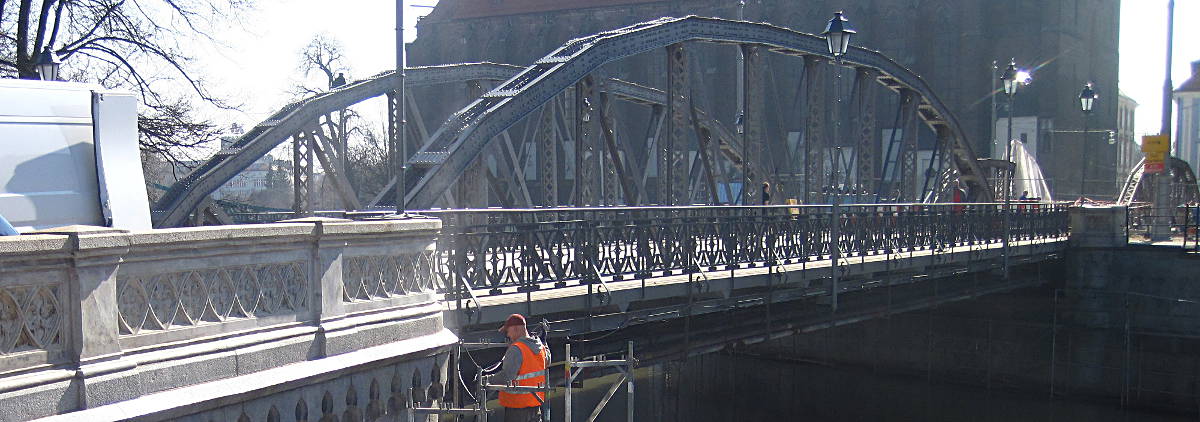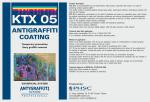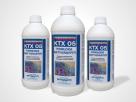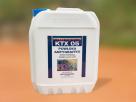-
 KTX 05 certificate:
KTX 05 certificate:Has obtained Road and Bridge Research Institute (IBDiM) approval.
-
 Appreciation from artists:
Appreciation from artists:Has received positive opinion from the University of Arts.
-
 Perfect temporary protection:
Perfect temporary protection:graffiti is easily removed with hot water.
-
 KTX 05 coating:
KTX 05 coating:vapour-permeable, single-component,
seven-year durability.
KTX 05 sacrificial coating
Main features and advantages of KTX 05 anti-graffiti coating:
- one-time protection - colourless drying anti-graffiti coating based on micro-waxes,
- applied in just 2 layer,
- immediate protection against graffiti paint and other atmospheric pollution,
- the resulting separation layer is easily washable with hot water,
- vapour-permeable,
- hydrophobic - reduces penetration of water and harmful substances,
- solvent-free,
- protects against UV radiation - does not turn yellow,
- for use on a variety of substrates,
- 7 years durability,
- finish: semi-matt,
- biodegradable,
- application by roller, air and airless spraying,
- National Technical Assessment of the Institute of Road and Bridge Construction,
- certified with: B construction mark,
- for use on monuments - positive opinion of the Academy of Fine Arts in Cracow.
Product description
KTX 05 is a one-component and water-based product which is colorless after drying and is used for protecting surfaces against graffiti. The coated surface is protected against aerosol spray paints, water-based markers, atmospheric pollution, dirt, acid rain and moisture. After application, KTX 05 accumulates on capillaries and pores’ walls as a separating layer, which prevents penetration into the substrate and reduces adhesiveness of paints/pigments. The coating is performed using two layers.
KTX 05 is a hydrophobic preparation, has preservative properties as well as UV filters, thanks to which the colour of the protected surface remains unchanged. It reduces mineral substrates’ permeability to water and harmful substances. The substrate colour tone becomes slightly deeper, while the gloss increases a little with the surface texture remains unaffected.
Technical Approval:
Road and Bridge Research Institute No. IBDiM-KOT-2022/0841.
Appearance on the substrate
The coating has a satin look, which may be more or less visible depending on the substrate type, amount and angle of sunlight incidence. Some absorbent substrates e.g. concrete, sandstone may become darker.
Areas of application
KTX 05 can be used for protection of both smooth and porous substrates, made from building materials: brick, clinkier, mineral plasters, acrylic, silicone, silicate paint coatings, concrete, natural stone such as sandstone, granite, travertine, as well as sculptures, monuments and thermal insulating systems. It cannot be applied onto unabsorbent substrates. For old paint coatings, it is recommended that preliminary tests should be conducted for coating removal with hot water/high pressure removal.
Not suitable for rotten substrates.
Substrate
Substrate must be cleansed of any atmospheric pollutants, dirt, harmful substances, oil, grease as well as stains of biological or organic origin. Thanks to the cleansing capillaries and pores absorb the protective preparation. The residue of cleansing substances may adversely influence the functioning of KTX 05 so it has to be thoroughly removed, too.
High concentrations of salts may result in serious construction damage which cannot be prevented by using impregnation. The part of the elevation which should not be affected by the protective coating should be covered with construction foil.
Application conditions
KTX 05 can be applied onto dry surfaces. Application of the coating onto wet substrate will cause its deep penetration into the material and ineffective protection against graffiti. Anti-graffiti coating should be formed on the outside of the protected substrate. KTX 05 can also be applied onto previously impregnated surfaces – it reduces coating consumption. Relative air humidity should not exceed 95%.
Substarate temperature: from + 7°C to +30°C.
Application
Before application, shake or stir the preparation with a slow-running mixer.
KTX 05 can be applied using typical painting tools: rollers or brushes (they must be well soaked with the preparation) or flow coating method, with an airless hydrodynamic spraying device with a 12 -17 wide spray nozzle, low pressure spraying.
Application of anti-graffiti coating: +7°C to +30°C.
Drying time at temp. of +22°C: approx. 15 minutes.
The coating must be applied thoroughly, filling all cracks and irregularities in the surface. Neglecting this may cause difficulties in removing graffiti. KTX 05 can be applied in two layers according to the "wet on wet" principle of applying consecutive layers, i.e. the following layer must be applied just before the first one reaches initial dryness stage (powder dryness) in the single work cycle – the substrate should be still damp.
If streaks appear because of the agent surplus, they should be smoothened before drying with a roller. Consecutive layers cannot be applied after the previous layer has dried.
If another layer is applied, it may result in visible droplets/streaks accumulating on the surface of the first layer. This is because a super-hydrophobic layer is created which due to its surface tension repels water-based agents and dirt pouring down with rainwater.
If some corrections are necessary, they must be done immediately. All the layers in the course of application should be protected against rainfall for approx. 2 hrs.
On 24 hrs of the application the coating assumes its anti-graffiti properties and becomes fully resistant after 7 days. Large amount of sunlight may accelerate vehicle evaporation, which may adversely affect the cross-linking of the coating. In order to avoid contamination of the coating with bacteria and fungi from the surrounding air, the packaging must be open only with the purpose of pouring a portion and closed tightly.
Once opened, the whole content should be used up as soon as possible.
Removing graffiti
Graffiti can be removed using a high-pressure cleaner with water temperature of 80°C to 120°C and pressure from 40 to 140 bar at a distance of approx. 20 cm. Before taking to actual graffiti removal the cleaned space should be warmed up with a weak hot water jet (approx. 80°C). Before starting, the substrate durability should be checked and water jet parameters as well as removal technology (water cleaner or chemical remover). If water temperature is to be 80°C on the cleaned surface, it must be suitably higher inside the container. Graffiti can also be removed by the KT 01 chemical remover. KT 01 can be applied with a brush or spray. After several seconds to several minutes one can remove the graffiti with an absorptive cloth or rinse it with warm water. On removal of the graffiti the substrate should be protected again (in line with the instructions) as the protective film is removed along with the graffiti painting. The protected substrate may be damaged if the pressure/temperature is too high, or if a fast-rotating nozzle or a thin nozzle jet is used, or if the cleaning end of the lance is too close to the surface.
Wear
The basic rule is to apply two layers and use the appropriate amount of coating per 1 sq. m. Do not exceed the recommended consumption values.
Theoretical spread rate: 5 m²/L (0,20 l/m²) to 10 m²/L (0,10 l/m²)
Theoretical spread rate refers to approximate values denoting extreme consumption figures which may vary depending on the type of the protected substrate.
Smooth absorbent surfaces without texture: 5 m²/L (0.20 l/m²) jointly for two layers e.g.: plasters, brick, concrete, sandstone.
Smooth non-absorbent surfaces without texture: 10 m²/L (0,10 l/m²) jointly for two layers e.g.: surfaces covered with elevation paint, anticorrosive or hydrophobic paints.
How does the KTX 05 work?
The sample pictures below show the difference in effectiveness between removing graffiti from a surface protected by KTX 05 and from a natural, unprotected material.
Removal of graffiti in the underground passage 1
Removal of graffiti in the underground passage 2
The Technical Approval required numerous tests of KTX 05, conducted in accordance with the following standards:
- PN-EN 1062-3:2008 Paints and varnishes – Coating materials and coating systems for exterior masonry and concrete – Part 3: Determination of liquid water permeability.
- PN-EN 1542:2000 Products and systems for the protection and repair of concrete structures – Test methods – Measurement of bond strength by pull-off.
- PN-EN 1767:2008 Products and systems for the protection and repair of concrete structures – Test methods – Infrared analysis.
- PN-EN ISO 2811-1:2012 Paints and varnishes – Determination of density – Part 1: Pycnometer method.
- PN-EN ISO 3219:2000 Plastics – Polymers/resins in the liquid state or as emulsions or dispersions – Determination of viscosity using a rotational viscometer with defined shear rate.
- PN-EN ISO 3251:2008 Paints, varnishes and plastics – Determination of non-volatile-matter content.
- PN-EN ISO 7783:2012 Paints and varnishes – Determination of water-vapour transmission properties – Cup method.
- PN-EN ISO 9001:2009 Quality management systems – Requirements.
- ASTM D6578 Standard Practice for Determination of Graffiti Resistance.
The following test procedure were used in the approval process:
- Test procedure of the Road and Bridge Research Institute: PB/TM-1/13 Assessment of protective coating (or lining) condition after freeze resistance testing.
The following reports of construction product tests were used in the approval procedure:
- Tests by the Road and Bridge Research Institute, Report of the Road and Bridge Research Institute 2016.







